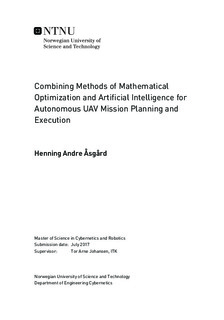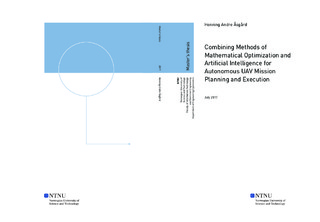| dc.description.abstract | In this thesis, different solutions for autonomous mission planning and execution aimed at Unmanned Aerial Vehicles (UAV) is investigated using methods of Artificial Intelligence (AI) and Mathematical Optimization. Different configurations of these solutions is then implemented as an Autonomous Mission Planning and Execution (AMPE) system in order to test the online performance of the complete system, and the different individual models that composes the system. Inspired by the T-REX architecture, the system is divided into modules handling the plan in different levels of refinement in a hierarchical manner. Where applicable, modules will be tested and compared when implemented by AI and Mathematical Optimization and the advantages and disadvantages will be discussed. The system should be able to plan with a certain amount of resources in mind, continuously update the plan using state feedback, and perform the plan by using the plans current actuator inputs. In order to keep clear goals for the the AMPE system, it is designed with a specific case in mind. Both the implemented capabilities and the discussion of results will focus on off-shore data gathering from sensors where the distances causes the required bandwidth impossible to achieve for direct communication. Several UAVs will cooperate in order to collect the data by creating a delay-tolerant communication network, and will seek to do so in some optimal manner. The different levels of the planning problem will be solved using Nonlinear Model Predictive Control (NMPC), Mixed Integer Linear Programming (MILP) and domain models for EUROPA. The tools ACADO, AMPL, EUROPA and T-REX will be used to implement the AMPE system with parallel, synchronous deliberation of the planning levels.
Simulations will be performed which shows that using the MILP optimization with data flow constraints are note applicable for a real world system as it uses hours to solve a plan. However, by finding plans in a static mission, the EUROPA solvers will show that it is much more efficient and ways of combining EUROPA and MILP in the future will be discussed. Simulations is done to show re-planning capabilities when the mission is affected by poor flight dynamics, dynamic resource consumption and dynamically positioned nodes.
In the end we will see how this system can be quite easily expanded so that the case of this thesis is only a specialization of a much broader domain of problems solvable by a more general system. A system where a mission problem would be defined as a top-level nddl domain model, and then solved automatically throughout the AMPE pipeline. The thesis will conclude with how a system based on purely Mathematical Optimization is ill-fitted for real-time demands, and how AI and Mathematical Optimization can be combined for autonomous mission planning and execution. | |

